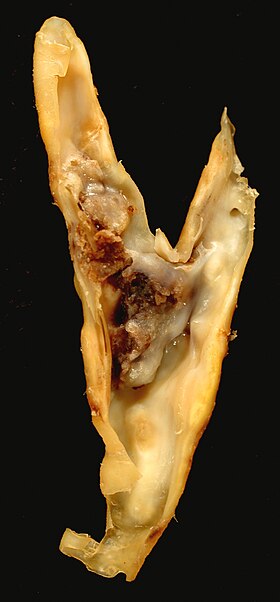Carotid endarterectomy
| Carotid endarterectomy | |
|---|---|
 Carotid endarterectomy specimen. The specimen is removed from within the lumen of the common carotid artery (bottom), and the internal carotid artery (left) and external carotid artery (right). | |
| ICD-9-CM | 38.1 |
| MeSH | D016894 |
Carotid endarterectomy is a surgical procedure used to reduce the risk of stroke from carotid artery stenosis (narrowing the internal carotid artery). In endarterectomy, the surgeon opens the artery and removes the plaque. The plaque forms and thickens the inner layer of the artery, or intima, hence the name of the procedure which simply means removal of part of the internal layers of the artery.
An alternative procedure is carotid stenting, which can also reduce the risk of stroke for some patients.
Medical uses
Carotid endarterectomy is used to reduce the risk of strokes caused by carotid artery stenosis over time. Carotid stenosis can either have symptoms (i.e., be symptomatic), or be found by a doctor in the absence of symptoms (asymptomatic) - and the risk-reduction from endarterectomy is greater for symptomatic than asymptomatic patients.
Carotid endarterectomy itself can cause strokes, so to be of benefit in preventing strokes over time, the risks for combined 30-day mortality and stroke risk following surgery should be < 3% for asymptomatic people and ≤ 6% for symptomatic people.[1]

Carotid endarterectomy does not treat symptoms of prior strokes. It is controversial if carotid endarterectomy can improve cognitive function in some patients.[2]
Symptomatic
Symptomatic people have had either a stroke or transient ischemic attack.
In symptomatic patients with a 70–99% stenosis, for every six people treated, one major stroke would be prevented at two years (i.e., a number needed to treat of six).[3]
Unlike asymptomatic patients, symptomatic people with moderate carotid stenosis (50–69%) still benefit from endarterectomy, albeit to a lesser degree, with a number needed to treat of 22 at five years. In addition, co-morbidity adversely affects the outcome: people with multiple medical problems have a higher post-operative mortality rate and hence benefit less from the procedure. For maximum benefit people should be operated on soon after a stroke or transient ischemic attack, preferably within the first 2 weeks.[3]
Asymptomatic
Asymptomatic people have narrowing of their carotid arteries, but have not experienced a transient ischemic attack or stroke. The annual risk of stroke in patients with asymptomatic carotid disease is between 1% and 2%, although some patients are considered to be at higher risk, such as those with ulcerated plaques. This low rate of stroke means that there is less potential stroke risk-reduction from endarterectomy for asymptomatic patients relative to symptomatic patients. However, for asymptomatic patients with severe carotid stenosis (80-99%), carotid endarterectomy plus treatment with a statin medicine and anti-platelet therapy does reduces stroke risk further than medication alone in the five years following surgery.[4]
Complications
The most feared complication of carotid endarterectomy is stroke. Risks of stroke at the time of surgery are higher for symptomatic (3–5%) than asymptomatic patients (1–3%).[5]
Bleeding, infection, and
Long term complications include restenosis of the endarterectomy bed, although the clinical significance of this is controversial in asymptomatic patients.
Reasons to avoid
The procedure should be avoided when:
- There is complete internal carotid artery occlusion
- The person has a previous complete hemispheric stroke on the ipsilateral and complete cerebrovascular territory side severe neurologic deficits (NIHSS>15), because there is no brain tissue at risk for further stroke damage.
- People deemed unfit for the operation by the surgeon or anesthesiologist due to comorbidities.
High risk criteria for carotid endarterectomy include the following:
- Age ≥80 years
- Class III/IV congestive heart failure
- Class III/IV angina pectoris
- Left main or multi vessel coronary artery disease
- Need for open heart surgery within 30 days
- Left ventricular ejection fraction of ≤30%
- Recent (≤30 days) heart attack
- Severe lung disease or chronic obstructive pulmonary disease
- Severe renal disease
- High cervical (C2) or intrathoracic lesion
- Prior radical neck surgery or radiation therapy
- Contralateral carotid artery occlusion
- Prior ipsilateral carotic endarterectomy.
- Contralateral laryngeal nerve injury
- Tracheostoma
Procedure

An incision is made on the midline side of the
History
The endarterectomy procedure was developed and first done by the Portuguese surgeon Joao Cid dos Santos in 1946, when he operated an occluded subsartorial artery, at the
